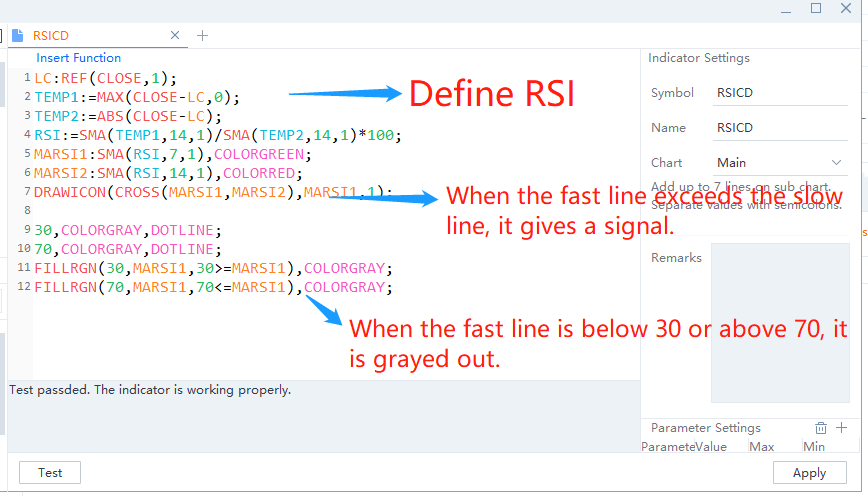RSI-Bottom Hunting Tool
Hey everyone! 👋
I've been watching a lot of experts on moomoo, like @ZZZZakk, learning a ton about technical analysis. Trying to brush up on my college knowledge too! Today, I want to share with you my recent exploration of the RSI - a powerful tool for bottom hunting!
The RSI (Relative Strength Index) is a momentum oscillator that measures the speed and magnitude of a security's price movements. Developed by J. Welles Wilder Jr. in 1978, it helps identify overbought and oversold conditions, as well as potential price reversals.
🔍 Key Points:
1️⃣ The RSI fluctuates between 0 and 100.
2️⃣ Calculation: The RSI calculates the average gains and losses over a certain period and uses these values to compute the indicator. The formula is:
RSI = 100 - (100 / (1 + RS))
Where RS is the ratio of average gains to average losses.
3️⃣ Overbought & Oversold Zones:
Overbought: When the RSI exceeds 70, it suggests that the market is overbought and may experience a price correction or decline.
Oversold: When the RSI falls below 30, it suggests that the market is oversold and may experience a price rebound or rally.
4️⃣ Trend Confirmation: The RSI can also be used to confirm trends. If prices make new highs (or lows) without the RSI making new highs (or lows), it could signal a potential trend reversal.
💡 Simple Strategy Overview:
The core logic of this strategy is to identify overbought and oversold signals indicated by the RSI and use these, combined with the indicator's value range, to generate buy and sell signals.
Buy Signal: When the short-term RSI (e.g., 7-day SMA) crosses below the long-term RSI (e.g., 14-day SMA) and then crosses up again, it's a potential buying opportunity.
Sell Signal: Conversely, when the short-term RSI crosses above the long-term RSI and then the long-term RSI crosses up the short-term, it could be a selling opportunity.
🚀 Key Advantages:
Trend Tracking: Especially effective in capturing profitable price movements in uptrending assets.
Dynamic RSI Integration: The RSI indicator enhances entry signals by avoiding overbought conditions.
In uptrending markets, this strategy often outperforms a simple buy-and-hold approach.
I've been watching a lot of experts on moomoo, like @ZZZZakk, learning a ton about technical analysis. Trying to brush up on my college knowledge too! Today, I want to share with you my recent exploration of the RSI - a powerful tool for bottom hunting!
The RSI (Relative Strength Index) is a momentum oscillator that measures the speed and magnitude of a security's price movements. Developed by J. Welles Wilder Jr. in 1978, it helps identify overbought and oversold conditions, as well as potential price reversals.
🔍 Key Points:
1️⃣ The RSI fluctuates between 0 and 100.
2️⃣ Calculation: The RSI calculates the average gains and losses over a certain period and uses these values to compute the indicator. The formula is:
RSI = 100 - (100 / (1 + RS))
Where RS is the ratio of average gains to average losses.
3️⃣ Overbought & Oversold Zones:
Overbought: When the RSI exceeds 70, it suggests that the market is overbought and may experience a price correction or decline.
Oversold: When the RSI falls below 30, it suggests that the market is oversold and may experience a price rebound or rally.
4️⃣ Trend Confirmation: The RSI can also be used to confirm trends. If prices make new highs (or lows) without the RSI making new highs (or lows), it could signal a potential trend reversal.
💡 Simple Strategy Overview:
The core logic of this strategy is to identify overbought and oversold signals indicated by the RSI and use these, combined with the indicator's value range, to generate buy and sell signals.
Buy Signal: When the short-term RSI (e.g., 7-day SMA) crosses below the long-term RSI (e.g., 14-day SMA) and then crosses up again, it's a potential buying opportunity.
Sell Signal: Conversely, when the short-term RSI crosses above the long-term RSI and then the long-term RSI crosses up the short-term, it could be a selling opportunity.
🚀 Key Advantages:
Trend Tracking: Especially effective in capturing profitable price movements in uptrending assets.
Dynamic RSI Integration: The RSI indicator enhances entry signals by avoiding overbought conditions.
In uptrending markets, this strategy often outperforms a simple buy-and-hold approach.

👇 Here's the indicator formula code. Feel free to copy and use it! 👇
LC:REF(CLOSE,1);
TEMP1:=MAX(CLOSE-LC,0);
TEMP2:=ABS(CLOSE-LC);
RSI:=SMA(TEMP1,14,1)/SMA(TEMP2,14,1)*100;
MARSI1:SMA(RSI,7,1),COLORGREEN;
MARSI2:SMA(RSI,14,1),COLORRED;|
DRAWICON(CROSS(MARSI1,MARSI2),MARSI1,1);
30,COLORGRAY,DOTLINE;
70,COLORGRAY,DOTLINE;
FILLRGN(30,MARSI1,30>=MARSI1),COLORGRAY;
FILLRGN(70,MARSI1,70<=MARSI1),COLORGRAY;
Application Example
LC:REF(CLOSE,1);
TEMP1:=MAX(CLOSE-LC,0);
TEMP2:=ABS(CLOSE-LC);
RSI:=SMA(TEMP1,14,1)/SMA(TEMP2,14,1)*100;
MARSI1:SMA(RSI,7,1),COLORGREEN;
MARSI2:SMA(RSI,14,1),COLORRED;|
DRAWICON(CROSS(MARSI1,MARSI2),MARSI1,1);
30,COLORGRAY,DOTLINE;
70,COLORGRAY,DOTLINE;
FILLRGN(30,MARSI1,30>=MARSI1),COLORGRAY;
FILLRGN(70,MARSI1,70<=MARSI1),COLORGRAY;
Application Example

I tried using this strategy on $Alphabet-A(GOOGL.US$ on the daily K-line chart and successfully captured some buying opportunities in uptrends.

By combining it with overbought zone signals, I also achieved good results with $Alibaba(BABA.US$.
However, it's worth noting that the RSI's predictions are not 100% accurate and require consideration of the specific market sentiment and suitable assets.
However, it's worth noting that the RSI's predictions are not 100% accurate and require consideration of the specific market sentiment and suitable assets.
🤔 Personally, I've found that highly liquid and popular stocks, as well as those with large market capitalizations, tend to provide the most accurate signals when using the RSI bottom-hunting indicator.
I hope this sharing is helpful to you all! Feel free to share your thoughts and learning experiences too! 💬
I hope this sharing is helpful to you all! Feel free to share your thoughts and learning experiences too! 💬
Disclaimer: Community is offered by Moomoo Technologies Inc. and is for educational purposes only.
Read more
Comment
Sign in to post a comment

Daytrading_Jaxx : A very helpful sharing!
Ohine : great!